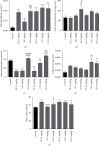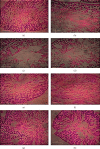Harmful Consequences of Proton Pump Inhibitors on Male Fertility: An Evidence from Subchronic Toxicity Study of Esomeprazole and Lansoprazole in Wistar Rats
- PMID: 35529080
- PMCID: PMC9072022
- DOI: 10.1155/2022/4479261
Harmful Consequences of Proton Pump Inhibitors on Male Fertility: An Evidence from Subchronic Toxicity Study of Esomeprazole and Lansoprazole in Wistar Rats
Abstract
Proton pump inhibitors (PPIs) are frequently prescribed as gastric acid-suppressing agents. Nevertheless, there is limited evidence supporting the risk of detrimental effects of PPIs on male fertility. The purpose of the current study was to evaluate the effect of subchronic use of proton pump inhibitors on male fertility. Seventy adult male Wistar rats were assigned into seven groups. The normal control group orally received solvent only. Groups 2, 3, and 4 were orally given esomeprazole while groups 5, 6, and 7 received lansoprazole at 2.5, 5, and 10 mg/kg/day, respectively. After 45 days of treatment, blood samples, epididymis, and testis were collected. Sperm count, motility, and morphology were determined. The level of hormones such as testosterone, follicle-stimulating hormone (FSH), and luteinizing hormone (LH) and oxidative status of testis tissue, such as superoxide dismutase, catalase, reduced glutathione, malondialdehyde (MDA), and nitric oxide (NO) were estimated. Results demonstrated a significant decline in sperm count, motility, morphology, testosterone, and catalase at 10 mg/kg/day and GSH at 2.5 mg/kg/day. A significant increase in FSH, LH, and MDA at 10 mg/kg/day and NO at 2.5 mg/kg/day was found as compared to the control group. The pathological alterations specifically dilation of Leydig cells, vacuolization, and degeneration of the seminiferous tubules were also evident. It is concluded that PPIs had caused male reproductive toxicity in Wistar rats due to altered levels of hormones such as testosterone, FSH, and LH, elevated levels of NO, and oxidative stress.
Copyright © 2022 Namra Mumtaz et al.
Conflict of interest statement
The authors declare that they have no conflicts of interest.
Figures






Similar articles
-
Endocrine disruption: Reproductive toxicity of glyceryl trinitrate and isosorbide mononitrate in male Wistar rats.Andrologia. 2022 Sep;54(8):e14482. doi: 10.1111/and.14482. Epub 2022 Jun 1. Andrologia. 2022. PMID: 35648594
-
Vitamin E administration does not ameliorate tramadol-associated impairment of testicular function in Wistar rats.Andrologia. 2020 Feb;52(1):e13454. doi: 10.1111/and.13454. Epub 2019 Nov 13. Andrologia. 2020. PMID: 31721272
-
Dietary fluted pumpkin seeds induce reversible oligospermia and androgen insufficiency in adult rats.Syst Biol Reprod Med. 2019 Dec;65(6):437-450. doi: 10.1080/19396368.2019.1612482. Epub 2019 May 13. Syst Biol Reprod Med. 2019. PMID: 31081692
-
Evaluation of the reproductive toxicity of naproxen sodium and meloxicam in male rats.Hum Exp Toxicol. 2015 Apr;34(4):415-29. doi: 10.1177/0960327114542886. Epub 2014 Jul 16. Hum Exp Toxicol. 2015. PMID: 25034942
-
Neonatal estrogen exposure of male rats alters reproductive functions at adulthood.Biol Reprod. 2003 Jun;68(6):2081-91. doi: 10.1095/biolreprod.102.010637. Epub 2003 Jan 8. Biol Reprod. 2003. PMID: 12606459
Cited by
-
Proton pump inhibitors affect sperm parameters by regulating aquaporins.Heliyon. 2023 Jul 1;9(7):e17911. doi: 10.1016/j.heliyon.2023.e17911. eCollection 2023 Jul. Heliyon. 2023. PMID: 37539124 Free PMC article.
References
-
- Monteiro C., Marques P. I., Cavadas B., et al. Characterization of microbiota in male infertility cases uncovers differences in seminal hyperviscosity and oligoasthenoteratozoospermia possibly correlated with increased prevalence of infectious bacteria. Ameriacn Jounral Reproductive Immunology . 2018;79(6) doi: 10.1111/aji.12838.e12838 - DOI - PubMed
LinkOut - more resources
Full Text Sources

